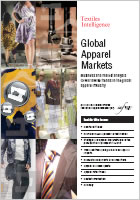Issue
2:
2nd Quarter 2008

Product Overview
Buy this Issue now
Subscribe
Download brochure (PDF)
Download price list (PDF)
Price list download
| Please choose your preferred currency:
|
Request sample issue
View list of reports
in other issues
|
Multi Report Package |
We also offer a flexible subscription product,
the Multi Report Package,
which allows you to select your own choice of reports from our full range,
to suit your own budget.
Click here for full details.
|
|
 |
Is China losing its competitive edge in clothing? |
|
published in Issue 2, 2nd Quarter 2008
|
Indications that China may be losing its competitive edge are becoming increasingly common. One report, in EmergingTextiles.com, referred on May 15, 2008, to "China's 'Textile Crisis'" ? noting that "a rising yuan [renminbi] and higher raw material and labour costs are negatively affecting China's competitiveness".
On the face of it, there is little to suggest that the industry is in trouble. In 2007 China stepped up its textile exports to the world by almost 16%1. Clothing exports rose by almost 21%. Admittedly, these increases were less buoyant than in 2006, when growth of 19% in textiles and 29% in clothing was achieved. But the 2007 growth rates are hardly those of an industry in crisis.
Production figures for 2007 tell a similar story, and provide further evidence to suggest that the industry in China is still booming. Output of man-made fibres rose by 15%, yarn production also increased by 15% and fabric output stood 10% higher. In the clothing and footwear sector, the industry's added value climbed by 17%.
| Global Apparel Markets provides intelligence, analysis and insight on the global apparel industry. |  | What's in it?
Each issue contains: essential information on trade and trade policy; news from leading brands, companies and other organisations; analysis of key geographical markets; and expert opinions on strategy. A single issue of Global Apparel Markets includes:  practical and strategic advice from industry experts practical and strategic advice from industry experts  a report on a key geographical market a report on a key geographical market  a round-up of the latest product innovations a round-up of the latest product innovations  a feature on trade and trade policy a feature on trade and trade policy  comprehensive information on the latest business developments comprehensive information on the latest business developments
An annual subscription to Global Apparel Markets is a cost-effective way to keep informed about trends and developments in the global apparel industry. Subscriptions are available in printed and/or digital formats. Printed and digital subscribers receive each issue in printed format in addition to a digital PDF file, which is available immediately on publication. Subscribers also receive a complementary digital subscription to Global Apparel Update, delivered directly by email once a month. This free supplement contains essential information on business news and the latest product developments. Like all Textiles Intelligence publications, Global Apparel Markets is a reliable source of independently sourced business information, and it does not carry advertising.
| This is what our customers say: |
"In our work, we were looking for industry insights and trends - who the major suppliers were, which countries were producing and what, productivity rates, investment incentives, where investors were moving to and why, etc. A lot of the individual country case studies you did were great - I remember one recently on the UK for example. There was also a great article from a guy on the Turkish market and recent trends there. Both these articles were written for the layman so they were easy to understand but comprehensive at the same time.
The technology articles were also interesting.
Basically, it was an all-round good publication that covered everything in enough depth so that you would always find something of interest in each issue." |
| (Alan J. Saffery; Competitiveness, Private Sector & Economic Growth ; Saffery Consulting) |
|
|
 |
